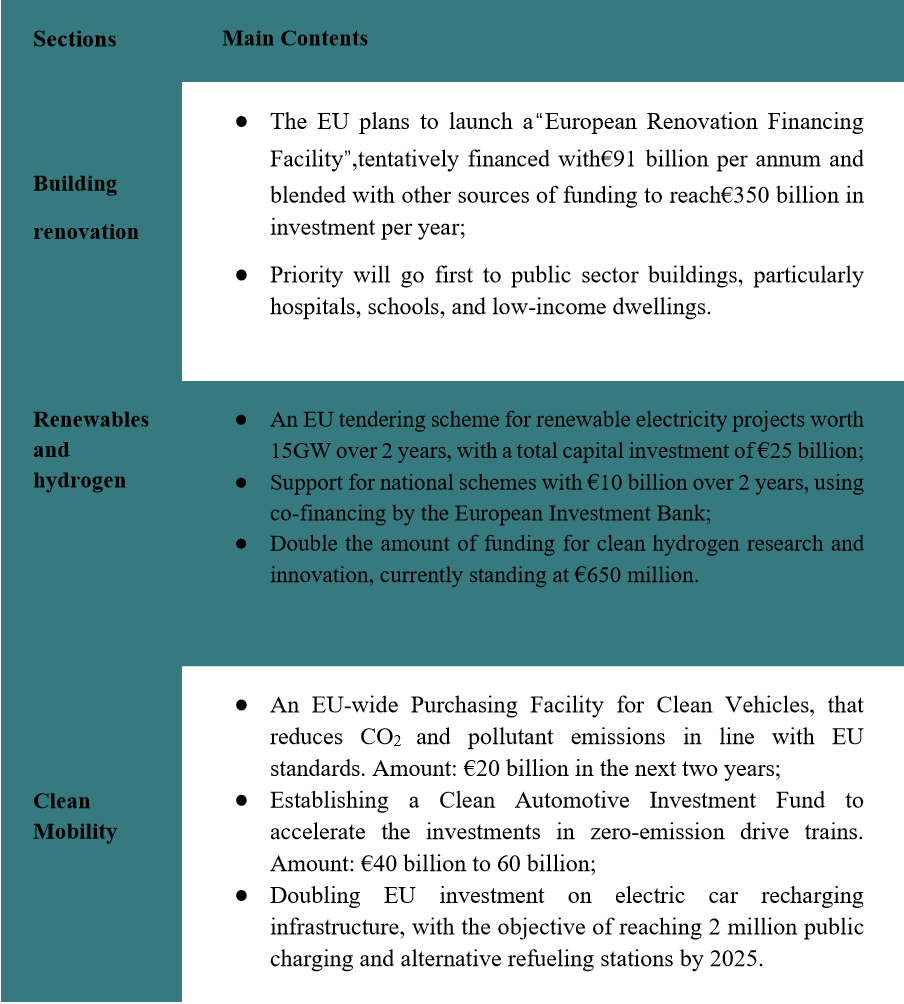

The first article in the series entitled “Launching a ‘Green Recovery’ to ensure sustainable economic growth after COVID-19” outlines that green economic recovery measures can not only revitalize the economies of all countries after COVID-19, but also become the most cost-effective way to tackle climate change. As a leader in advancing the development of green economy, the European Commission has placed the “European Green Deal” at the core of European economic recovery plan. This article will give a brief introduction to the green economy part of the “Recovery Plan for Europe” recently released by the European Union, as well as several green economy measures in the “Green Recovery Plan” draft.
The European Recovery Plan
“Just Transition Fund” accelerates the transition to climate neutrality
On May 27th, the European Commission announced an economic stimulus plan called "Next Generation EU", which will provide €750 billion for member states hit by the pandemic, including €500 billion in grants and €250 billion in loans [1]. Urrasu von Der Leyen, the President of the European Commission, said that about a quarter of the recovery funds in the “Next Generation EU” plan will support measures to promote the development of the EU’s green economy. For example, a proposal to increase the "Just Transition Fund”by up to €40 billion will not only invest in clean energy projects but also provide retraining opportunities for workers whose livelihoods are affected by the energy transition.
The European Green Recovery Plan
Increasing investment in green economy development projects
According to the EurActiv reports, the draft of the “EU Green Recovery Plan" mainly includes three sections – building renovation, renewables and hydrogen, and clean mobility (Table 1) [2]. In order to alleviate energy scarcity and improve energy efficiency, the European Union launched a "building renovation wave" in September last year, with the goal of tripling the current 1% renovation rate. The “Green Recovery Plan”will accelerate the renovation target through an annual investment of €350 billion, and priority will go first to public sector buildings, especially hospitals and schools.
In addition, the renewable energy market has also been seriously affected due to the COVID-19 crisis, with solar and wind markets expected to shrink by 20%-33% this year [3]. The European Commission believes that renewable energy and sustainable hydrogen technology will play a key role in future economic decarbonization. Therefore, renewables and hydrogen projects will receive financial support of different scales in the“Green Recovery Plan”. In terms of clean mobility, the EU is considering providing incentives to auto manufacturers to produce and sell clean energy vehicles, as well as investing in electric car recharging infrastructure to drive the transition of the EU’s auto industry to electric vehicles.
Table 1. Main contents of the EU “Green Recovery Plan” draft.

Conclusion
Although the EU“Green Recovery Plan" draft mentions increasing investment in green projects, it overemphasizes the future green investment plan of the auto industry in terms of clean transportation. This may be due to the two major automobile manufactures in the EU, Germany and France, which dominate the EU policymaking. Aviation, however, as a major industry for global carbon emissions growth in the future, also needs corresponding green measures.
In addition, as the first East Asian country to clearly propose a green recovery, South Korea announced a“Green New Deal”plan in March this year. The plan mainly includes a carbon tax, gradually phasing out domestic and overseas coal financing, and increasing investment in renewable energy to achieve net zero emissions by 2050[4]. Thus, as the world's major economies and CO2 emitters, the EU and South Korea are actively taking climate change into account in their economic recovery plans, while in China, a large amount of funds will be invested in a new round of infrastructure projects after the “Two Sessions”. Among these new investment projects, green and low-carbon projects should account for more than half of proportion, which could lay the foundation for China’s more resilient and sustainable economic growth in the future.
Notes:
[1] Recovery Plan for Europe, Link: https://ec.europa.eu/info/live-work-travel-eu/health/coronavirus-response/recovery-plan-europe_en
[2] Green Recovery Plan Draft, Link: https://www.euractiv.com/wp-content/uploads/sites/2/2020/05/Green_recovery_plan.pdf
[3] Leaked: EU’s draft ‘green recovery’ plan, Link: https://www.euractiv.com/section/energy-environment/news/leaked-europes-draft-green-recovery-plan/?utm_campaign=Carbon%20Brief%20Daily%20Briefing&utm_medium=email&utm_source=Revue%20newsletter
[4] In East Asia first, South Korea announces ambitions to reach net-zero by 2050, Link: https://www.eco-business.com/news/in-east-asian-first-south-korea-announces-ambitions-to-reach-net-zero-by-2050/
Author: Yating Yuan
Proofread by Jiaqiao Lin
Translated by Lu Ye(Intern)
This article is an original article of the Rock Environment and Energy Institute. Please contact us to obtain the appropriate authorization to reprint.
For cooperation and authorization, please send an email to: liying@reei.org.cn
* This is the translation of an article in Chinese. Should there be any inconsistency between Chinese and English version, the Chinese version shall prevail.




